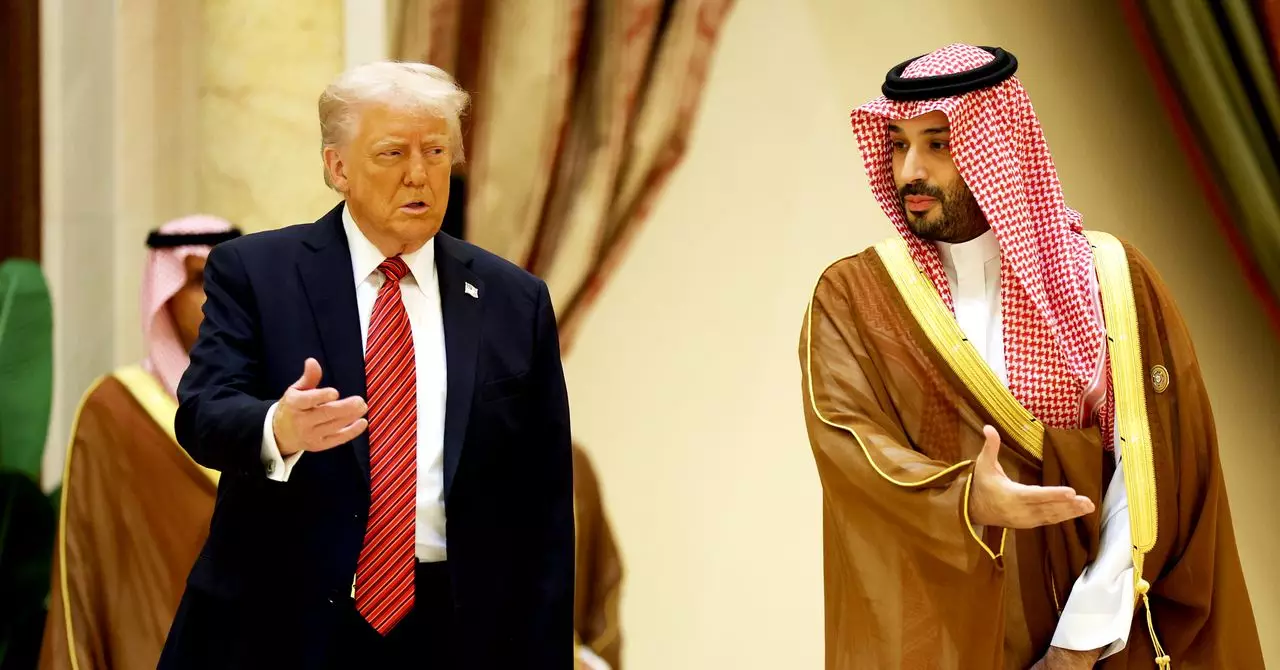In an audacious demonstration of international diplomacy and techno-economic partnerships, former President Donald Trump’s visit to the Middle East embodies a strategic shift toward collaborative advancements in artificial intelligence (AI). Accompanied by a cadre of tech moguls, Trump’s agenda showcased initiatives poised to reshape the techno-political landscape, especially in the realms of AI and data infrastructure. The backdrop of this journey, a fighter-jet escort, speaks volumes about the gravity and ambitions underlying these new alliances.
During the final leg of this tour in Abu Dhabi, Trump heralded a groundbreaking collaboration between unnamed U.S. tech firms and the United Arab Emirates (UAE), aiming to establish the largest AI datacenter cluster outside the United States. This venture, spearheaded in partnership with G42, an Emirati company, promises an impressive five gigawatts of AI computing prowess in the UAE. Sheikh Tahnoon bin Zayed Al Nahyan, a pivotal figure leading the UAE’s Artificial Intelligence and Advanced Technology Council, heralded this move as a transformative opportunity, indicating that it would solidify the region’s status as a beacon of innovative research and sustainable development.
The Emergent Giant: Saudi Arabia’s AI Aspirations
In the shadows of Abu Dhabi’s announcements, Saudi Arabia simultaneously unveiled “Humain,” a state-backed AI investment initiative. As part of a strategic plan developed by the kingdom’s Public Investment Fund, Humain forged partnerships with major U.S. technology players like Nvidia, AMD, Qualcomm, and AWS. With these alliances, Saudi Arabia aims to elevate its technological capabilities, establishing it as a significant contender in the global race for AI supremacy.
Trump’s rhetoric during his visit to Riyadh indicated an optimistic vision of economic alliances, where U.S. and Saudi businesses could transact hundreds of billions of dollars in various sectors, including infrastructure and defense. Such deals not only promise robust economic benefits but also a pioneering transformation, enabling Saudi Arabia and the UAE to broaden their roles within the global tech ecosystem.
Why AI Matters: Strategic Resource Allocation
At the heart of this diplomatic and economic entanglement is the strategic assertion of control over AI infrastructure and resources. The negotiated agreements promise significant allocations of computing capacity — notably, Saudi Arabia’s projected procurement of Nvidia’s advanced GPUs, which would enable the nation to potentially create leading-edge AI models. In quantitative terms, estimates suggest the acquisition of approximately 250,000 high-performance GPUs, a massive leap in capabilities that could redefine the nation’s technological landscape.
AWS also expressed its commitment to investing in AI infrastructure in Saudi Arabia, pledging a joint $5 billion investment alongside Humain. This investment is positioned as a crucial component of a broader strategy to not only harness cutting-edge technologies but also pivot the region away from traditional oil dependency towards a diversified, tech-driven economy.
Geopolitical Implications and the Future of AI Technology
While the financial potential of these AI partnerships is undeniable, the geopolitical implications warrant further scrutiny. The Middle East, particularly nations like Saudi Arabia and the UAE, finds itself in a unique position, harboring immense financial resources due to oil revenues and keenly seeking technological evolution. However, these countries also maintain critical business relations with China, which could complicate the fabric of U.S. interests in the region, especially amidst an escalating global rivalry.
In a curious turn of events, just days prior to Trump’s engagement in the Middle East, his administration decided to roll back a significant regulatory framework that would have restricted the sales of advanced semiconductors to certain countries, including Saudi Arabia and the UAE. Many perceive this decision as a strategic retreat aimed at ensuring that American tech firms retain their foothold in a rapidly evolving AI market. Critics argue that such moves risk enabling adversarial nations to access sensitive technologies, thus altering the balance of power within the global landscape.
The Road Ahead: Collaborative Future or Competitive Struggle?
As this new chapter unfolds in the story of global AI development, one must ponder the future trajectory of these partnerships between the U.S. and the Middle East. While the promise of wealth and technology exchange generates enthusiasm, there are underlying tensions that could lead to competition rather than collaboration. The ambition to innovate, combined with the geopolitical intricacies of power dynamics, poses questions about how emerging players—Saudi Arabia and the UAE—will navigate their newfound prowess in AI amidst existing powers.
Ultimately, the pursuit of technological advancement in these regions will depend not only on concerted investments and strategic alliances but also on responsible governance and ethical standards in AI development. Each nation’s commitment to fostering a cooperative ethos will be pivotal in determining whether we witness a flourishing partnership or a contentious rivalry in the fast-evolving domain of artificial intelligence.

